Max Allan Collins's Blog, page 20
March 1, 2022
Quarry Hits the Big Times
It’s been ages since I’ve had a New York Times review of one of my novels. I’ve had some nice write-ups there – don’t recall a bad one – but this is the first ever Quarry novel the Times has reviewed. Here goes:
With QUARRY’S BLOOD (Hard Case Crime, 224 pp., paper, $12.95), Max Allan Collins finally bids goodbye to Quarry, his Marine sniper-turned-professional assassin, more than 10 years after The Last Quarry, by its title, promised to do so. This time feels like it’s for keeps, as the novel is set more or less in the present (there’s a reference to a character dying of Covid), and Quarry, pushing 70, is looking forward to retiring after all those decades of killing for hire.Retirement, however, is put on ice when a true-crime writer, Susan Breedlove, shows up at Quarry’s door looking for some answers. Her arrival opens a portal into full-on metafiction, as the line between what Collins has published since the mid-1970s and what has spilled out into the actual world (like a television adaptation) grows so porous as to cease existing.
It goes without saying that the body count will pile up, and that Quarry, despite his aching body and slower reflexes, still operates at a more ruthless clip than almost anyone he encounters. This is a sure-footed ending to a series that marinated in the excesses of pure pulp.
That’s a swell review, but what’s interesting to me is to how the word “pulp” has become a compliment in recent years – possibly thanks to Quentin Tarantino’s Pulp Fiction – when for decades it was a pejorative. Now it denotes a certain style of fiction (often consciously retro) viewed with a positive, even affectionate spin.
Equally interesting to me is that this is the first I’ve had a paperback original reviewed in the Times, at least that I can remember.
So far the reader response, and reviewer reaction, has been very warm indeed to the new Quarry. It was a risky novel to write, as you readers of the book already know, because I ventured into “meta” territory, big-time. I don’t want to say more, but I will say that one of the things I dealt with is just what exactly Quarry has been writing in these first-person narratives all these years.
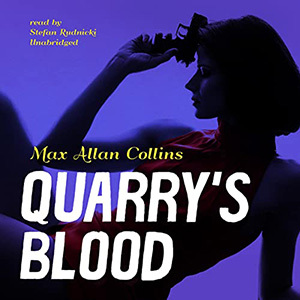
Digital Audiobook:

Out right now is the audio book of Quarry’s Blood, read by the wonderful Stefan Rudnicki. The cover is pictured here. I have not listened to the audio yet, but will begin sometime this week, when we take a day off to celebrate my 74th birthday. (It’s March 3rd, not yet a national holiday.)
Stefan has become the voice of Quarry for me, just as Dan John Miller is Nate Heller.
Check out an excerpt here:
* * *I am working on the new Heller novel now, ridiculously immersed in it, and for that reason this will be a short update. I would like to respond to Bill P’s follow-up comment on a discussion about writing, readers and reviewers that’s been going on for a few weeks here. I misunderstood Bill’s use of “archetype,” thinking he meant the characters I write about; but he was thinking of the archetypical reader I envision.
I accidentally answered that, by saying that I write to please myself, and my wife Barb, who is my first reader as I go along (meaning she reads the chapters as I complete them). I do, however, envision a reader. I don’t think specifically of a male or female, just someone who shares my interests and tastes, and the ideal reader is probably of my generation or the generation or two on either side of mine. A major part of my approach is my assumption that the reader is at least as smart as I am. He or she might be smarter, but not so much smarter that my work seems childish or beneath them. I never assume – never – that the reader isn’t as smart as I am. I endeavor never to write down.
The only slight exception – the only “sort of” exception – is when I write a first-person story in the voice of someone not as smart as me. I’ve only done this a few times, and it’s tricky (Shoot the Moon is one). This relates as well to writing in the point of view (when in third person) of someone who isn’t as smart as me. Who might be dumb, like Lyle in Spree. All I can say is that these characters never think of themselves as dumb, just as the antagonists of the protagonists never think of themselves as the villains.
I’ve made it clear here that I abhor writing that tries to impress – that spends too much time showing off. In this approach, the story almost always pays the price.
* * *
I wanted to share with you this cover of the graphic novel Quarry’s War in Spanish.
I don’t remember Quarry appearing in Spain before. Road to Perdition did, which may be what led to this edition.
Here is a very smart review of Quarry’s Blood. This reviewer is always worth reading.
M.A.C.
February 22, 2022
Who I Try To Please
No book giveaway this week. To make up for it I am including a cute photo of our two grandchildren, Lucy and Sam, taken at the Muscatine Art Center’s lego display. You’re welcome.

 * * *
* * *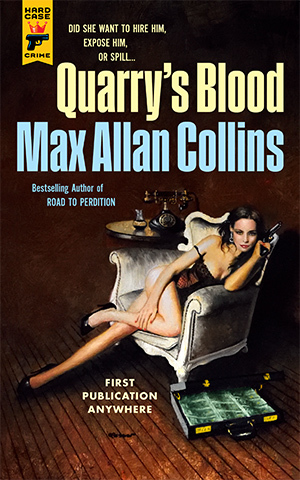
Paperback:







E-Book:





Patience – another book giveaway will come. I just don’t want to detract from the release today (Feb. 22) of Quarry’s Blood. And winners in that book giveaway, will on that date be able to post reviews on Amazon.
* * *And speaking of Quarry’s Blood, I want to share this great review from Ron Fortier at Pulp Fiction Reviews:
QUARRY’S BLOODBy Max Allan Collins
Hard Case Crime
Max Allan Collins has been writing stories about his Vietnam veteran hitman since 1976. It was obvious from the start that the author and his creation were the same age making it easy enough for him to place the stories in time. Collins did a few Quarry books and then walked away from them. When Hard Case Crime came along, publisher Charles Ardai, a fan of the character, urged Collins to bring Quarry back. Collins, obviously older, as was his hero, realized he had a golden opportunity to write a finale.
What his crystal ball couldn’t predict was how successful “The Last Quarry” would become among his ever growing audience. And there was Ardai wanting more. Collins pulled a very neat hat-trick and went backwards with “The First Quarry.” Which of course meant dusting off his own memories of those long ago times and their social environs. All of which he did making it seem effortless.
Having thus given us the alpha and omega, it seemed we mystery/crime fans had seen the last of Quarry. Again we’ve been proven wrong in this new “Quarry’s Blood.” It’s pretty much a gripping fast paced epilogue and so much fun. We catch up with an aging Quarry, almost about to reach seventy and widowed for the second time. He’s content with living a quiet, if lonely life, until a very savvy female writer named Susan shows up on his doorstep. As it turns out she’s the author of a bestselling true crime novel that was clearly inspired by Quarry’s lethal career and she’s convinced he is the real hitman she researched in her book.
Unnerved by all this, he maintains his false innocence and sends her packing. The following day, while taking a pre-dawn swim at a nearby indoor pool, he’s nearly killed by two professional assassins. No way is it a coincidence and Quarry finds himself once again being pulled into his old world of hunter/prey, kill or be killed. But what’s the connection to Susan? And who, after so many long years, wants him dead and why?
This is one of the best Quarry books ever. Maybe we think that because we’re seventy-five, a Vietnam veteran and often times think about all our brothers who never made it home to their families and loved ones. Who never got to drink another cold beer or read a damn good book like this one. Thanks, Max, for all of them.
Thank you, Ron, for reading them. When a Vietnam vet reacts well to these books, I am especially pleased.
* * *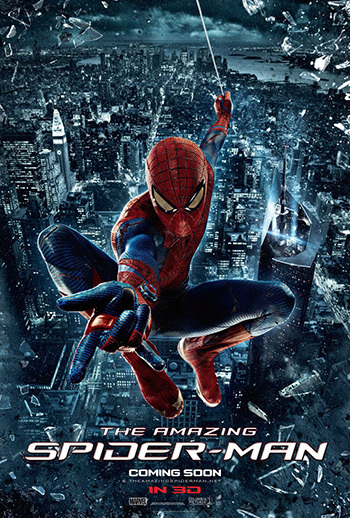
Okay, so sometimes I’m wrong.
Ten years ago, I thought The Amazing Spider-man with Andrew Garfield was lousy. But because I really liked the recent Spider-Man: No Way Home, in which all three big screen Spider-men were deftly woven into one narrative, I decided to pick up a 3-D Blu-ray of Amazing Spider-man (cheap) and Barb and I watched it tonight.
We loved it.
Part of this is our affection for Andrew Garfield in other films he’s been in that made us more open to his casting, and of course he’s very good in No Way Home. Part of it was how terrific the film was, really taking its time to explore the origin of the character in a way that was at once faithful to the original comic book and at the same time fleshed it out. Also, the attention by the filmmakers to mimicking artist Steve Ditko’s classic poses for Spider-man was thrilling to someone who had followed the character from Amazing Fantasy #15 and The Amazing Spider-man #1 to the end of the John Romita-drawn run.
Mostly our positive reaction, however, came from meeting the film on its own terms. This is true of novels and short stories, too. I’m a big believer in that, but I sometimes don’t take my own advice. In retrospect, I disliked the Garfield version of Spider-man, ten years ago, because I felt it was superfluous – that it was too soon to do a reboot (a term I don’t believe was in use yet). As a Sam Raimi fan – I saw Army of Darkness in a theater on its first release – I liked his version just fine, though the third one was not up to snuff. But Toby McGuire’s Peter Parker/Spider-man (should I have inserted a “SPOILER ALERT” there?) seemed definitive.
Now reboots are part of the plan, and No Way Home has rather brilliantly found a way to make all three versions of Spider-man at the movies exist in the Marvel Universe.
I mention this not just indicate any growth on my part, but as an adjunct to discussions here (on the update/blog itself and in the comments) about the value of reviews. I don’t recall if I reviewed Amazing Spider-man here ten years ago, but if I did, I probably panned it.
A review is just an opinion, and a snapshot of how the reviewer reacted to a film or novel at that time. Opinions can change, and they often should. I am always after my readers to post reviews at Amazon, and have made my preference for receiving good reviews no secret. But it really doesn’t have much with making me feel good (okay, a little), but mostly to help market the books. To draw attention to them and encourage new readers.
In the comment section last week, Bill P said the following:
So, if you as an author realize this is a collaboration with the reader, do you have an archetype in mind during writing for the intended audience? Does thinking of their acceptance/rejection of your choices guide you or limit you? And when you try to grow from that core audience from book to book, do you find some reject you extending those boundaries because they want the constancy of the world you have previously created?I answered this last week, in the comments; but I think Bill raises topics worth discussing in a bit more depth.
I love my readers – money gets sent to my house because of them. But the truth is I write for only two people – Barb and myself. Primarily I write for me, because I am always trying to write a book that I would like to read. I am trying to satisfy my needs and express my ideas and to make something. Create something. Barb is secondary in this process, but incredibly important. I cannot imagine writing if she were not reading what I’ve written.
Now, that doesn’t mean she reads everything – she certainly skips introductions and essays and such that I occasionally write. But all of my fiction goes to her as my first reader (with novels, a chapter at a time). One reason for that is her abilities as a writer – even before she developed her skills along those lines, she had incredible story sense, and a remarkable bullshit detector. She knows when something isn’t working in a scene.
Also, and you’ll have to forgive the sentiment here, but I love her and want to please and impress her. To make her think I was worthy of her spending her life with me. I need to impress her because a lot of the time I am a buffoon.
Being my critic-in-chief isn’t an easy role for her. I hate criticism. I have a thin skin. (Not a desirable trait in a writer.) (Or anyone.) Sometimes I don’t react well. But generally she knows how to handle me (sad that she has to) and I know she is trying to protect me. Yes, from myself.
I don’t make any attempt to please readers by writing the same kind of thing every time out. For a long time, in the movie and TV tie-in days, I had to write all sorts of things to make a living. It was good for me, because I learned a lot writing in different genres – the movie novels, as I’ve mentioned here, included war, western, romance, science-fiction, sword and sorcery, horror and other themes forbidden to me in my narrowly defined role as a mystery writer.
But within mystery fiction, not everything I do pleases every reader of mine. When I do something like John Sand, occasional howls of displeasure have arisen. It’s probably no surprise that fans of Quarry might not be interested in the cozy comic Antiques novels. Quarry and Nolan fans sometimes find the longer length and historical approach of Nathan Heller off-putting, though Heller and Quarry and Nolan are cut from similar cloth.
I can’t help that. First, I need to make a living, and second, I need to stay fresh and interested. If I were doing one Quarry novel after another, in a row, I’d likely grow tired and to hate him. As it is now, it’s like spending time with an old, good friend (who kills people).
I do make concessions both to publishers/editors and to the type of book I’m doing. I have a sense of what’s appropriate for a given title. For John Sand, Matt Clemens and I decided to be very sparing with the “f” word – we hardly use it at all, whereas Quarry and Nolan and Heller readers know I am not fucking afraid to use it. In the Fancy Anders novellas and The Many Lives of Jimmy Leighton, that kind of effing profanity just didn’t seem appropriate. It wouldn’t be in the Antiques novels, either.
To me that’s just bringing to a given novel what is appropriate for that novel, and, yes, its audience. I don’t think that’s selling out – I think it’s being a conscientious professional.
I don’t know how to answer Bill’s archetype question. All of the first-person narrators are me – me in different circumstances, but me. In writing tough guys like Nolan, Quarry, Heller, even Mike Hammer, I strive to make their surfaces – and their inner lives – reflective of each being a real person. Not a type.
M.A.C.
February 15, 2022
Bulldog Edition
It’s amazing! After my brief discussion/defense of the Ritz Brothers last time, fan clubs for the boys have sprung up all over America!
Okay, maybe not.
I’m just softening the blow that I’m not doing a book giveaway this week. Maybe next week. I am working on the new Nate Heller and found myself scrapping my intended final two sections and plotting instead one second section. This required re-reading a ton of research material and re-thinking it. I have been taxing my wife Barb’s patience utilizing her as a sounding board whose ideas and reactions are always helpful.
And how about that Super Bowl? Actually, as I write this, it hasn’t happened yet and I don’t care about it, so Barb and I will be going to the new Death on the Nile at a time when the theater should be largely empty.
* * *Barb and I have now seen Death on the Nile (in an almost empty theater!) and we both found it a whipsawing experience. Kenneth Branagh’s version of Poirot is perfectly acceptable and often pays attention to detail courtesy of the Christie (and Suchet) characterizations; but he falls prey to an out-of-character attraction he has to a raucous blues singer, based on Sister Rosetta Tharpe, whose music is used throughout in a sometimes jarring way – where we should be getting a John Barry-esque score over the majestic Nile as backdrop to all this glitzy but murderous melodrama, we get guitar-driven blues (and a traditional soundtrack playing at a barely audible level, as if the theater left its Muzak going). I like guitar-driven blues, but as the soundtrack to Agatha Christie?
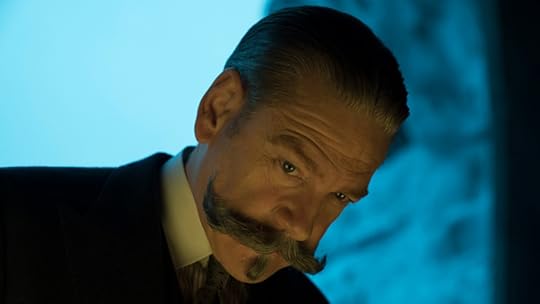
Though relatively faithful to Christie in general, the substitution of the blues singer and her manager/niece for the drunken romance novelist and her daughter seems at once forced modernity and a clumsy removal of a valid murder motive. A nice WW I origin story for Poirot and his mustache is followed by Poirot in 1937 going to a nightclub and sitting alone at a table watching over-choreographed lascivious dancing in quiet perverse contemplation – it’s a creepy sequence, turning the Belgian master detective into a raincoater in a porn-shop booth.
When the riverboat-board mystery kicks in, the cast proves less than star-studded (and filled, by accident of course, with cancelled or sort of cancelled celebrities of a few moments ago) though the direction is fine, save for circling cameras and other stunts during interrogation scenes that only detract from the importance of the information being gathered. When Branagh hews close to Christie, which he does about two-thirds of the time, his performance and the film itself are fine.
The biggest flaw is Gal Gadot playing the woman-stealing rich girl in a positive manner, not Lois Chile’s grasping, acquisitive proper murder victim of the superior 1978 version. And for all the emotion Branagh tries to stir up, no performance here touches ‘78’s Mia Farrow, the spurned woman of one of Dame Agatha’s most chillingly convoluted plots.
I’m glad to see Christie staying in the popular culture, although Covid and the mine field of who is cancelled by the time a film comes out has done this Poirot film no favors.
* * *My discussion last week sparked quite a bit of response, after I revealed my negative opinion of a certain James Crumley first sentence, even while granting an I-hope-not-condescending-permission for others to like it. Some of those responses appeared in the previous Comments Section, but still others were sent to me by e-mail. One of the most interesting came in that fashion, and – with permission – I am sharing it here, so I can reply and perhaps have my response seen by more readers than if this had occurred in the Comments Section.
The following is excerpted from a missive courtesy of a reader who wishes to remain anonymous:
“Your blog is your house. I think good discourse is important, but I also respect your site as your medium to transmit your message. No need to raise Cain in another man’s world. That said, I do like the Crumley line and state it here, privately. (NOTE FROM MAC: Privately until I got hold of it.)“Perhaps it’s because, when my Dad was in the creative writing program in Montana, he met and drank with Jim (called some of his work mediocre too…you might have liked that!). Maybe it was the many ‘ramshackle joints’ like that one described that my Dad dragged us to as kids. Maybe it is because my college roommate was from Sonoma, who had an alcoholic father that just might have drank in the same bar. Maybe it is because I have never thought about a bulldog that was an alcoholic, much less an owner who would give him such a big name as ‘Fireball Roberts.’ Those all play, I’m sure, and made me want to know more. But, having lived on the Gulf Coast in my young adulthood, I know what it is like to ‘drink the heart right out of a fine spring afternoon.’ Maybe you can’t go back, but that sentence fragment brought me there for a short moment.”
My anonymous correspondent has made – or anyway implied – a point that I tried to make last time. It’s part of the overall concept of the reader as collaborator. I’ve discussed that my propensity for providing what some think is over-description (of clothing, or setting, etc.), and have tried to explain that this comes from my desire to be the in-charge half of the collaborative team.
First, I would like the reader to experience what I imagined, what I conjured, as close to the way I did. Second, I don’t think it should be the reader’s responsibility to do the writer’s work. Why should you have to clothe the damn characters? Why should they be allowed to run naked through the pages, unless it’s a sex scene or set in a nudist colony? Why should you have to describe the circumstances of where these fictional people live and put the flesh on the bones the stingy writer did not deign to provide?
Now I say this specifically in regard to my work. I don’t propose it as a schematic, or “rules,” other writers should follow. This approach reflects, as it has no choice other than to do, my way of seeing things. In the comments, one reader agreed with me about the overwriting in the Crumley line, then started quoting Elmore Leonard’s rules, most of which I disagree with…for me, not for Leonard. He was excellent at following his own rules and came up with something special…and his. I was a fan of Charles Webb, the little-known author of The Graduate, and he was the stingiest writer I ever encountered – he gave you nothing but the action and words of the piece, which may be why his famous novel became an even more famous movie…it was already almost a screenplay.
My anonymous correspondent’s comments about his dad, and the way his father related to bars and drinking (I am almost a non-drinker, despite the mimosa I had this morning), are him bringing himself to the party. He can’t help doing that any more than I can avoid bringing my opinions and personal history to the party. And neither of us should try otherwise. That’s where the collaboration between writer and reader becomes interesting.
It’s also why you can love a writer, and recommend that writer to a perfectly intelligent friend, and then have your own intelligence questioned by that friend because of your terrible taste in books. (This obviously also applies to movies and music.) That is why all reviews – mine included (see Death on the Nile above) – are essentially worthless…because none of us have the same experience when we read a book (or see a movie or listen to music).
You can tell somebody a book is great, but the truth is the version that person experiences will be at least somewhat different from yours, and probably a whole lot different. I have spent my life dueling with people who don’t like Mickey Spillane. I have very little respect for their intelligence. And they have very little respect for mine. Neither of us is wrong, at least not entirely.
The one area where I would disagree with my anonymous correspondent is a style issue. I don’t object to any of the things Crumley jams into the sentence (well, I think “Fireball Roberts” is a terminally cute name for a bulldog, and Abraham Trahearne is almost as bad for a human), it’s just the show-offy way he goes about it. It’s impossible (or difficult) (or maybe I’m just slow) to chug-a-lug all that one sentence’s information.
What I do like about that line is that it provides information even as it raises questions – that’s how many, perhaps most, good first sentences succeed. A good first sentence doesn’t require you to read it more than once to make sense of it, to process it, unless you think it’s a bad idea to pull your reader down immediately into the narrative and make forward progress.
This is a first sentence that I much admire:
“Later that summer, when Mrs. Penmark looked back and remembered, when she was caught up in despair so deep she knew there was no way out, no solution whatever for the circumstances that encompassed her, it seemed to her that June 7th, the day of the Fern Grammar School picnic, was the day of her last happiness, for never since then had she known contentment or felt peace.”That’s plenty long, but you are right with it, and solid facts accompany cascading questions. It’s the first sentence of The Bad Seed by William March, and you can have your drunken bulldogs named Fireball What’s-It.
* * *I can’t resist reprinting this great review of Tough Tender from Booklist.
Tough Tender.By Max Allan Collins
Mar. 2022. Hard Case Crime, paper, $12.95 (9781789091434)
Collins’ Nolan series, starring the no-nonsense thief Nolan and his younger partner, comics crazed Jon, was written from the sixties into the eighties, but it had been largely unavailable for decades, until Hard Case Crime began reissuing the series as twofers under new titles. This is the third in that sequence, following Two for the Money (2021), and it combines Hard Cash and Scratch Fever. Nolan has no interest in robbing the same bank twice, but he’s blackmailed into doing so by the bank manager, who wants a share of the take this time. Naturally, it all goes crazy wrong. Scratch Fever picks up the story years later when Nolan and Jon encounter hairstylist-turned-entrepreneur Julie, who scammed them on the bank deal. Naturally, they’d like to get their money back, and just as naturally, Julie would like to get rid of them altogether. Collins displays his usual ability to round out the flat edges of what seem initially like stock genre characters, but he really outdoes himself with Julie, surely one of the most memorable femme fatales in hard-boiled fiction (“everything she touches turns to dead”).
— Bill Ott
And here is (incredibly enough) a really nice review of Double Down, another Nolan two-fer, from Kirkus.
Nolan also gets love at http://thebadnet.blogspot.com/, which gives me great pleasure, as it’s a site devoted to Lee Van Cleef. Scroll down when you get there (linger over the naked blonde if you like).
Finally, Road to Perdition gets a spot on this list of Best 21 books about the Mafia.
M.A.C.
February 8, 2022
The Ritz Brothers? That’s What You’re Reading?
We will be sending Tough Tender out tomorrow, and I remind those of you receiving copies that you can’t post Amazon reviews until the book has been published, which will be March 15. Same is true of the Quarry’s Blood winners, although that date is sooner – February 22nd.
I am mulling doing a giveaway of No Time to Spy next week. It’s such a big book that postage will be nasty, and I may limit the giveaway to five copies. We shall see.
I am working on the new Nate Heller right now and am about at the half-way point with an April 1st deadline. With luck I will make it, although I have jury duty next week. I actually enjoy jury duty (I’ve served twice in the past) but would rather write Heller.
I’ve talked a lot about the writing process lately, and bitched about reviewers. So for a change I thought I’d write some reviews, or at least reactions, myself to what I’ve been reading and seeing. Probably the question I get asked most – particularly by people who don’t read these updates and don’t already know the answer – is, “What are you reading?”
Again, frequent visitors here know I read very little fiction these days, and almost no crime fiction other than re-reading books by people who influenced me, like Spillane, Cain, Hammett, Chandler, Stout and Christie. (Most of my reading is non-fiction research.) The crime fiction I do absorb tends to be on TV or at the movies…but particularly TV. I’ll talk about what Barb and I have watched and enjoyed lately, but first…what have I been reading?
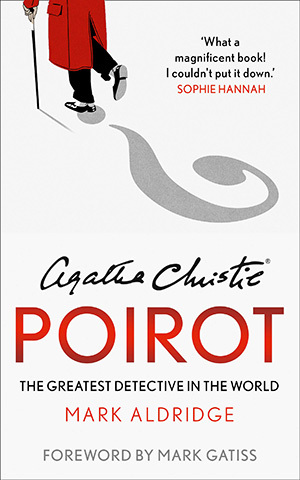
Poirot: The Greatest Detective in the World by Mark Aldridge is a massive and quite wonderful trip through every Christie novel about the Belgian detective as well as most of the short stories and the various adaptations, including films and TV. Though published with the Christie estate’s blessing, the book is not afraid to criticize (if fondly) the fiction and does not hesitate to find fault with adaptations, though never in a mean-spirited way. Amazingly, the book talks about each novel, intelligently, without revealing the solutions to any of the mysteries. And I was particularly pleased that the author agrees with me that Evil Under the Sun (1982) with Peter Ustinov is “an unmitigated joy” and the best Poirot film.

The Ritz Brothers by Roy Liebman is absolutely the best book on the Ritz Brothers ever written. Also the only one, but it’s damn good if organized in a somewhat head-scratching manner. The Ritz Brothers would be one of my prime guilty pleasures if I considered pleasures found in books and films and TV anything ever to feel guilt about. I say this fully cognizant that their film The Gorilla (1939), despite having a guy in a gorilla suit in it, is truly awful. I’ve seen it half a dozen times.
Sidebar: why do I like the Ritz Brothers? I find their eccentric dancing amazing and their lookalike goonery amusing. The biggest factor is probably Harry Ritz, the “funny” one (think Curly) (or, later, Shemp), without whom we would not have had Danny Kaye, Sid Caesar or Mel Brooks. Oh, and Jerry Lewis. That’s why. Also, their Three Musketeers movie is one of the best versions of one of my favorite stories, with the added benefit of getting Beaver Cleaver into a lot of trouble when he wrote a book report based on that movie.
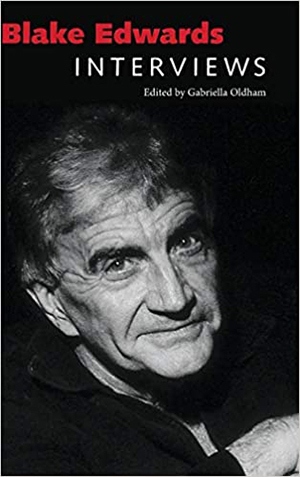
Blake Edwards: Interviews edited by Gabriella Oldham. The man who gave us Peter Gunn, The Pink Panther and The Great Race, but also gave us some films that make The Gorilla look pretty good, has fascinated me for years. Plus, he wrote and directed the first Mike Hammer TV pilot. And I bet he would have agreed with me about the Ritz Brothers.
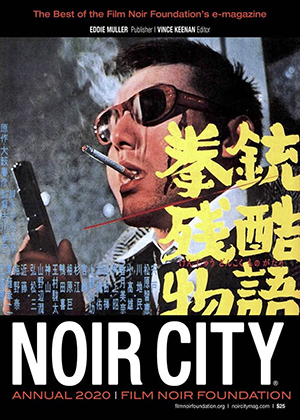
Noir City Annual 2020, Eddie Muller publisher, Vince Keenan editor. This publication routinely ignores me and my work, and yet I remain (largely) unoffended because Noir City is so great…and now is publishing as a monthly magazine. This annual covers postwar Japanese noir and actor Jo Shishido (my son Nate and I are fans) as well as Harper and Point Blank, Hubert Cornfield (who directed Bobby Darin in Pressure Point), Christa Faust on older women in noir, and so much more. (Drawback: no Ritz Brothers.) If you haven’t joined the Film Noir Foundation yet, there is still time to save yourself and do so.
That’s it for books lately (25 others are stacked and waiting by my bedside) but there’s been lots of TV. When I write all day, which is most days, I spend the evening with Barb (also writing most days) watching TV and enjoying stories other people have come up with. We binged (well, over two evenings) on the first part of the fourth season of Ozark, in which no one was safe (nor should they have been). I may discuss the series in depth when the second half of this last season appears later this year; but I will say it strikes me as the only true rival to Breaking Bad, with the exception of Better Call Saul.
We watch far more British mystery and crime series, however, than stateside stuff. I had to buy from an e-bay seller of current British (legal) DVDs to see season eight of Endeavour and season 6 of Shetland. (Amazon UK, where I used to do a lot of business, has hiked their shipping fees to the sky since Brexit and Covid, both of which are nasty diseases.)
The sixth season of Endeavour is three movie-length (90-minute) episodes linked by the increasing emotional isolation and drinking problem of its hero. Actor Shaun Evans, who has done the impossible by following the legendary John Thaw into the role of Morse (the young Morse admittedly), is a master at conveying little through his dialogue while conveying much through an understated yet absolutely readable performance. He is matched by another master of understatement, Roger Allam, as DI Thursday (his surrogate father), whose approach recalls Michael Caine at his best. The final episode of the three stumbles a bit, as writer Russell Lewis discovers how difficult it is to do an Agatha Christie-style closed-environment mystery – it entertains, but you will likely (as did Barb and I) glaze over during the convoluted solution. A season nine has yet to be confirmed, but there’s certainly more story to tell.
Shetland’s sixth series is one six-episode, six-hour story, rich in character and plot. Often locales are cited as characters in stories, and mostly that’s an exaggeration, but the austere beauty of the Scottish archipelago here rises to that. The storytelling approach is unique – long shots of cars on a narrow highway go on longer than might seem necessary, cliffs and oceans and fields stretch forever, cars pull up to lonely houses and people get out and walk slowly up to the door; but the leisureliness of that (normally a negative) is offset by crime stories that have twists and turns and characters who suffer one small (and occasionally large) crisis after another. The protagonist, Jimmy Perez (Douglas Henshall), is always on the move, making a steady progression through crime scenes and the police station itself, even his own kitchen at home, a presence knifing through the quiet. This is one of the best of the UK shows, and that’s saying something. A season 7 has been announced.
Netflix has two mystery-oriented shows that provide very different comic takes on crime.
The Woman in the House Across the Street from the Girl in the Window is, as its title tells you, a parody of the current female-dominated psychological thriller – everything from Hallmark movies to books (and movies) with titles like The Girl on the Train or, well, The Girl Most Likely. The star is Kristin Bell, Veronica Mars herself, and I guarantee that any working mystery writer will be uncomfortable at times, as the series nails the cliches all of us occasionally fall into.
I’m not sure whether Bell is the woman in the house or the girl in the window – depends on your perspective – but the series is just a good enough mystery to stay compelling despite the wonderful silliness (like the dim-witted handyman who is repairing the same mailbox throughout all eight episodes). Mostly it’s just amusing, but from time to time some truly outrageous moment – right out of Airplane! – will blindside you with hilarity. A few episodes in, the woman (or the girl?) played by Bell turns amateur detective; seeing Bell in Veronica Mars mode again, even in a spoofing way, is a pleasure…as I say this as one of the producers of the Veronica Mars film (well, as someone who gave enough to the KickStarter campaign to get a t-shirt). We watched one episode and wound up bingeing on the entire eight.
Or, as the girl (or woman?) would say, “Bingo!”
The other Netflix mystery series, derived from a UK source, is Murderville, which is essentially Police Squad Meets Whose Line Is It Anyway. A demented Will Arnett, making his Arrested Development role look grounded in reality, is Detective Terry Seattle in an unnamed big city. In each episode he is confronted by a murder to solve, and burdened with a new homicide department trainee – played by a celebrity with no script, who must muddle through the plot and the indignities with no one to help but Arnett, who basically is there to make their lives miserable. Every guest star did well, but Conan O’Brien, Kumail Ali Nanjiani and Ken Jeong are the standout trainees. We found it hilarious.
You know – like the Ritz Brothers.
M.A.C.
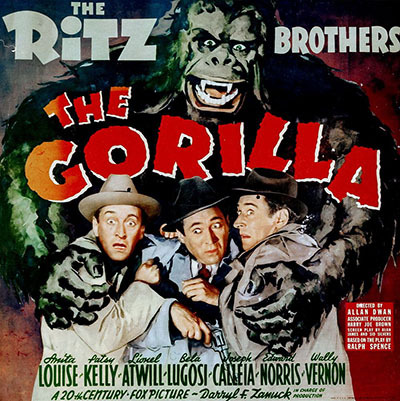
February 1, 2022
Not Another Book Giveaway! Also, Entertain or Impress?
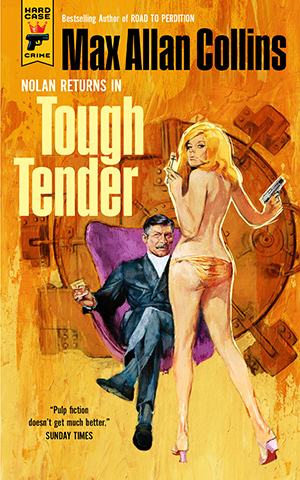
Paperback:







E-Book:






Yes, just one week later and it’s another book giveaway.
Hard Case Crime continues its wonderful (to me, anyway) series of Nolan reprints, with two novels to a volume and terrific, movie poster-ish Mark Eastbrook covers. Tough Tender, including both Hard Cash and Scratch Fever, will be published March 22. I have ten advance copies for readers willing to do a review at Amazon (and/or other Barnes & Noble and other review sites). This is USA only and (IMPORTANT) you must include your snail-mail address, even if you’re entered and won before. [All copies have been claimed. Thank you for your support!]
These novels were the last in the original Nolan cycle – all of them (save Scratch Fever) were written for Curtis Books in the early seventies, and later minorly revised when Pinnacle Books picked the series up. Only Bait Money and Blood Money (the first two) saw publication from Curtis Books in 1973. Scratch Fever was written expressly for Pinnacle, and would be the last Nolan until Spree in the eighties. Spree, designed to be the last in the series, has been followed by a “coda” novel, Skim Deep, out last year.
I continue to emphasize the importance of reviews at Amazon in particular. Some of these books – the Hard Case Crime titles and Titan titles – you can find in your favorite brick-and-mortar bookstore. But the likes of The Many Lives of Jimmy Leighton (by Dave Thomas and me, and a book I really love), Fancy Anders Goes to War (I love you, too, Fancy!) and No Time to Spy (the new John Sand omnibus by Matt Clemens and me) can only be ordered online – Amazon probably your best bet.
* * *As I mentioned in recent posts, I’ve decided to slow down my rate of production. In 2021 I amped things up, and you’ll be seeing the results in the coming months, in part due to this year’s 75th anniversary of the debut of Mike Hammer in I, the Jury. I am hopeful that Spillane – King of Pulp Fiction (the biography by Jim Traylor and me) – will get some special notice. An Edgar nomination is the dream, but Mickey Spillane on Screen by Jim and me, which I remain very proud of, was roundly ignored. Skim Deep got great reviews and was mentioned on not a single “Best of 2021 Mysteries” lists.
I talked a bit last time about books like mine that aim to entertain rather than impress. It’s the books that try to impress (and are often no fun at all) that get the acclaim. Frustrating as that can be, I don’t envy my peers who get the accolades. For one thing, I’ve had my share of honors over the years – maybe more than my share. For another, to be jealous of another writer you have to be willing to trade your book for one of theirs. I might like Angel in Black to have the sales and reputation of The Black Dahlia, but I wouldn’t swap it for a box of Edgars and a boxcar of money.
If writing isn’t about the writer, it isn’t about anything at all.
I mention The Black Dahlia only because a genuine frustration I feel comes from the countless times some well-meaning reader says to me, “You are one of two favorite writers. The other is James Ellroy.”
I usually don’t comment on other writers, and I won’t here, except to say Ellroy is the rare fellow writer I have at times admitted not caring for (his work – personally, our encounters have always been friendly). It just makes a writer’s brain hurt and maybe explode when fans say their other favorite writer is somebody whose work that writer deplores.
But it makes sense that somebody who likes Ellroy’s fiction might like both his and mine. We work the same side of the 20th Century true-crime street, which is enough to attract the same readers. Sex and violence and traditional hard-boiled themes occur in both of us. What somebody like me has to wrap his head around is this: a reader may have the capacity to like two very different approaches to the same subject matter. In fact, a reader should have the capacity to do that.
Writers, however, often have tunnel vision in this area. For me writing is a trial-and-error process. I don’t mean the plotting or the story selection or any of that. I refer to the actual word-for-word hammering it out, the way sentences are assembled, the way paragraphs get put together. On another level, thematic concerns come into play, albeit often subconsciously – world view.
What I am trying to do, in a perhaps stumbling way, is what I’ve been doing all along: attempting to perfect my approach to storytelling. This is one reason why I don’t read much fiction anymore, especially mystery/crime. I’m no longer interested in being influenced. On some perhaps naive level, I am trying to come up with The Way to Write Crime Fiction.
I should be glad that Ellroy’s approach differs so drastically from mine. I should understand that the reader is somebody who goes along Restaurant Row and sometimes eats Chinese and sometimes Italian, and loves both. Nothing wrong with that.
With Ellroy, I have encountered too many smart people who like his work to dismiss their opinions. I have come to accept that I have had a strong element of envy in my reaction to him, because he is more successful in terms of readership, acclaim, earning power, etc. But where he isn’t more successful (and is in no way trying to be) is as the author of Max Allan Collins novels.
Shakespeare said the play is the thing. From this we extrapolate that the novel is the thing – the fiction (short stories and movie scripts, too) a writer creates is the thing. I congratulate any writer who can manage to make a living doing this throughout a lifetime – even me.
Even James Ellroy.
Smart people’s tastes vary. Here is the sentence many consider to be the best first sentence in private eye fiction; it’s by James Crumley in The Last Good Kiss:
When I finally caught up with Abraham Trahearne, he was drinking beer with an alcoholic bulldog named Fireball Roberts in a ramshackle joint just outside Sonoma, California, drinking the heart right out of a fine spring afternoon.You may like it very much, and you won’t be the only intelligent human who shares that opinion. I think it’s a lousy first sentence, overloaded and too cute and trying way too hard. Really, just horrible.
We’re both right.
* * *Speaking of right, here’s a lovely review of The Many Lives of Jimmy Leighton from Ron Fortier.
Road to Perdition, the graphic novel, has made a list of the best 110 “thriller books.”
The film is highly regarded here.
And here.
M.A.C.
January 25, 2022
A Free Quarry Book, Plus Why Reviews Do and Don’t Matter
Here is an interview with me about two upcoming Hard Case Crime titles, Quarry’s Blood and Tough Tender, conducted by the great Andrew Sumner of Titan.
* * *
Trade Paperback:







E-Book:





And now – the first book giveaway of 2022. I have ten advance copies of Quarry’s Blood available to the first ten interested readers. [All copies have been claimed. Thank your for your support! — Nate]
More book giveaways will follow – I hope to get some copies of No Time To Spy to offer soon, and I have on hand advance copies of Tough Tender (which collects the Nolan novels Hard Cash and Scratch Fever), which will be given out possibly next time.
These reviews are extremely important in an era when I am no longer doing signings and haven’t done a convention since Covid came calling. Even brief reviews are appreciated, particularly since there are a handful of apparent trolls out there who want to make sure I can’t make a living during my dotage.
A No Time to Spy review, by the way, accuses you fine people of laziness, concluding: “And by the way most of the positive comments to the Sand trilogy as of today are copy and paste from the Collins blog.” (Feel free to defend yourself in the comments area under that review, which is by Robert Hölzl, who knows he hates all three Sand novels – would you keep reading a series you dislike? – but does not know how to spell my name.)
Just to clear the palate, here is a wonderful write-up from Facebook that just popped up out of nowhere, from Rick Greene:
I love the Quarry novels. They are all fast reads, masterful page-turners that one completes in one or two sittings, wildly violent, wickedly funny, the ultimate anti-hero. As much as I love Quarry – and the Spillane/Collins Hammer novels – I consider Max Allan Collins’ masterwork to be the Nathan Heller series. I’m just more than halfway through these detective thrillers that take real life crimes and revisit them via a fun house mirror. The Heller’s are NOT fast reads – they are dense, complex, deeply moving stories that often leave the reader emotionally shattered at the finale. You have to pay attention and turn the pages slowly. The Heller’s are books to savor, to immerse one’s self in. I’ve said before that the Quarry books are cake and ice cream where the Heller series are a five course gourmet meal. I love them all for different reasons. Collins is my favorite living author… and I hope he goes right on living and writing for a few more decades. Just imagine if Ian Fleming had lived another twenty years – the unusual and complex places he could have taken James Bond as they both aged together. I can’t wait to read about the true last Quarry adventure and to revisit Heller as much as Collins will indulge us with. Bring it on.This came at a lovely time because (a) the new Quarry book is about to be published, and (b) I have just started writing the new Nate Heller. And the Hellers have always been hard to write, but I find that, at my age, the process may be the same but I am not. I was struggling with the first chapter and then Rick Greene’s nice words came along.
What was really nice about these words is that they were just a heart-felt reader’s outpouring of appreciation – not a review. I feel like I can take Rick’s words to heart whereas it’s dangerous to believe any review, good or bad. And then there’s karma….
Later the same day I read Rick’s celebration of my work, I came upon a current review of (the 39-year-old) True Detective that was patronizing and close to nasty in things it said about my work. I write “bad dialogue,” I’m told, and the reader has to slog through my work, and as a stylist I have all the poetry of the directions on a paint can. I would have shared this condescending thing with you, but I failed when I tried to track it back down via Google.
The review was well-written and not stupid, although – as usual – no proof backing the opinions was provided. How about quoting a few clumsy sentences to make your point, or reprinting a particularly bad patch of dialogue? (By the way, I have been publishing since 1971 and have never before had my dialogue singled out for anything but praise.)
The danger for a writer – and let’s pretend Rick Greene was writing a review and not just a sending me a valentine – is that if you take the good reviews seriously, you have to take the bad ones seriously, too. And doing so will make a real writer – which is to say, a working writer who makes his or her living this way – crazy. I will admit that the day after I read that largely negative True Detective review, I found myself back at work on The Big Bundle, second-guessing every Heller sentence I wrote.
The truth is, many of us in the arts can remember every bad review – can quote from memory reviews dating back decades – whereas the positive ones fly away like tissue paper on the wind. It’s human nature, I guess, but at the same time I know that I have to pay no real attention to any reviews. I am past the point, fifty-one years into my novel writing career, that I can learn much. I do still learn, but it’s incremental, and it comes from trial and effort, not something a reviewer points out or suggests.
The True Detective reviewer clearly considered me a pedestrian stylist. Hey, I think I can turn a pretty fair phrase. But I can guess the writers that this reviewer likes – the ones who are writing to impress, not to entertain. I pick up books at Barnes & Noble or BAM! and read the first paragraphs by writers with reputations as stylists, writers far more celebrated than I ever will be, and what I see is overloaded, overwritten, trying-too-hard bullshit (do not ask for names).
Reviews, as far as my growth is concerned, are irrelevant to a writer who has been working as long as I have. All I know how to do at this stage is write the book I would like to read. Really, I think that should be every novelist’s goal – write a book you wish somebody else would have. Please your own taste and hope enough others out there will have similar enough tastes to keep you in business.
And yet I am doing a book giveaway, soliciting reviews. I don’t do this so that you will tell me how wonderful I am (though feel free to do so). I do it to help sell books, so I can stay in business. To get the word out.
I talk a lot here about how, in recent years, in recent days, I have felt cut off from current popular culture. Today I went over the copy edited manuscript of the second Fancy Anders (Fancy Anders For the Boys) and was told I shouldn’t mention Mantan Moreland or Jap Zeroes. How am I supposed to react to that? As someone who writes about the Twentieth Century, must I clean up that century’s idiosyncrasies and failings? Or do I have a responsibility to depict that century as accurately as my flawed memory will allow?
But the truth is, it’s harder for me now to be accepted in a world of publishing where I am white and old and male. It’s not the marketplace’s fault – it’s just the reality. I am so very, very lucky that publishers like Hard Case Crime, Titan, Neo-Text and Wolfpack still find me a worthwhile addition to their lists. In a world where I have to explain to people who Mickey Spillane and Mike Hammer are, I am damn lucky to still be in business at all.
* * *Some advance readers of Quarry’s Blood have nice things to say about it at Goodreads.
Check out this lovely piece at Crimereads on Marshall Rogers, who illustrated my brief run on the Batman comic strip.
Finally, has it really been twenty years since Road to Perdition was released?
M.A.C.
January 18, 2022
Reassessing Priorities & Fancy Anders Sounds Great
For the first time in four or five months, my band Crusin’ played a gig. Generally we haven’t played during the winter months for the past several years, but this was a private party for a 60th wedding anniversary for a couple who had employed us for their 50th (back when Andy Landers and Jim Van Winkle were in the band). Also, they are clients of our drummer, Steve Kundel, who is an attorney (when I introduce the band members on a gig, I usually mention Steve being a lawyer, saying we find it wise to travel with in-house counsel).
Anyway, like Steve McQueen said in The Magnificent Seven, it seemed like a good idea at the time (it was not yet winter when I booked the gig). Now as the job approached, it was clear Covid was kicking back in, and the job was in Iowa City (forty miles away) and a snow storm was predicted. We did not, however, cancel.
The snow arrived but was not such that we couldn’t make the trip with relative safety. We arrived at the Iowa City Eagles and were pleased to find it a very nice venue. None of us were crazy about playing a job in a college town, particularly so soon after the holidays, with Omicron (which sounds like a bad science-fiction movie) running rampant. But we wore masks loading in. Barb accompanied me and helped a great deal, both in setting up and making several key suggestions about what songs to perform (for example, advising me to open with a slow song and have the celebrating couple start the festivities alone, then asking the rest of the guests to join in).

The people were as warm as the night was not and there was dancing and a nice receptive response to our foolishness. A wonderful time was had by all. We’d only had two rehearsals to go back over the list and, surprisingly, we were pretty darn good. My bandmates, drummer Steve and guitarist Bill Anson and his son Scott Anson, who took over on bass when Brian Van Winkle passed, are fun to be around – very good company. At the rehearsals the absence of Brian’s sunny personality was keenly felt. Over the years the loss of bandmates – I’ve been playing rock ‘n’ roll since 1965 – is a wound that never really heals. Not a week goes by that I don’t think about my musical collaborator Paul Thomas.
I’ve had enough health problems that Barb has really been pitching in to help me set my stuff up and tear it down. I’ve talked here before about how the performances themselves are not any way burdensome, but loading up, setting up, tearing down, and loading back in will probably determine when I stop doing this. Musician friends have written me insisting that I should employ roadies, and these are mostly musicians who are getting paid the kind of money that allows that.
It occurred to both Barb and me, as we were driving up and back to the gig, that this might be my last performance with the band. Certainly it’s doubtful I would do more than one more summer season – last year, just four gigs. I would like to do a farewell appearance, and I’ve hoped to do one last CD – we were already working up originals and even playing them on the job when Covid hit and we lost over a year.
By the way, as you may have already noted if you follow these update/blogs, Barb is the best wife anybody ever had. She is smart, funny, thoughtful and beautiful. She does not, however, cut me undue slack – she knows just when I need to be cut down to size and reminded of reality. Which is of course frequent. But my God I am a lucky man.
My 74th birthday is approaching soon – March 3rd – and I find myself reassessing priorities. Last year I was crazily prolific, in part because I was doing my own fiction writing as well as putting the Mike Hammer 75th anniversary into motion. Adding in a 100,000-word biography to an already busy writing schedule took it out of me.
So while you may look to me to keep working as long as my noodle is functioning and I am above-ground, the pace is going to slow. I had to ask for an extension on the deadline for the new Nate Heller, The Big Bundle, after the unanticipated and most unwelcome return of kidney stones, which hadn’t reared their nasty, spiky little heads since 1998.
I have now begun The Big Bundle – one whole chapter is written (but also the research completed and the book worked up in chapter outline) – which is the first of a two-book RFK/Hoffa cycle (overall completing the Kennedy cycle begun by Bye Bye, Baby). Will these be the last Heller novels? Maybe. Right now my job is to complete these two. The Big Bundle will appear late this year, if all goes well.
* * *A benefit of the Iowa City band job was that Barb and I were able to finish listening to the audio book of Fancy Anders Goes to War from Skyboat Media. (You can read about it here)
I’ve been blessed by having mostly really good readers of my books on audio. The head honcho at Skyboat, Stefan Rudnicki, has been doing both Quarry and Mike Hammer and knocking the ball out of the park; recently he’s embarked on Nolan, in his usual stellar manner. When we submitted Fancy Anders to Stefan, however, I requested that he use a female narrator, specifically Gabrielle de Cuir. He and she came through for me, and how.
If you haven’t read Fancy Anders Goes to War yet, this is an excellent way to do so. If you have read it, it’s still well worth the ride (and the price of admission), because Skyboat has done a fantastic job. They’ve used music and sound effects to really create Fancy’s world. Gabrielle does a lovely job, superbly differentiating the characters and (unlike some male narrators with female characters) nails the men, as well.
Skyboat will be doing the next two Fancy Anders books, as well – Fancy Anders For the Boys and Fancy Anders Goes Hollywood. Both are written (Fay Dalton is almost finished with the second book’s illustrations) and should be out next year as e-books, book-books, and audios.
* * *Speaking of Fancy Anders Goes to War, here’s a great review of it at the Mostly Old Books and Rust review blog.
And the great James Reasoner likes Fancy, too – check this out!
Quarry’s Blood, not quite out yet, is already getting some swell reviews at Goodreads.
Finally, here’s a great look at the Nolan series.
M.A.C.
January 11, 2022
Happy Birthday, Mike Hammer – All Year!
So it’s 2022 and that makes it the 75th anniversary of Mike Hammer.
More specifically, it’s the 75th anniversary of the publication of I, the Jury (1947), the first Hammer novel. The character, arguably, begins with Mike Lancer, who appeared in one story written by Spillane and drawn by Harry Sahle, “Mike Lancer and the Syndicate of Death,” in Harvey’s Green Hornet comic in 1942. Lancer became Mike Danger, although none of the comics stories were published till 1954.
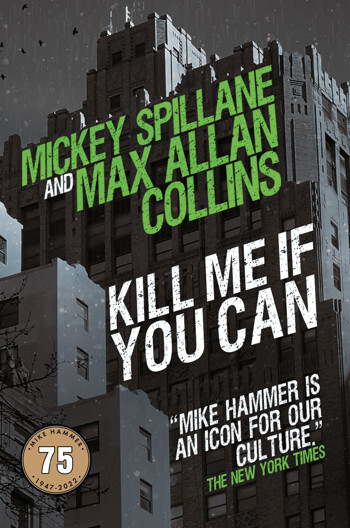
Hardcover:





E-Book:





If you’ve been following this update/blog, you may recall that we have a lot of special things in store this year for the Hammer birthday celebration. I have used several unproduced TV scripts by Mickey to write the 2022 novel, Kill Me If You Can, available in August (and for pre-order now). The book is the prequel to The Girl Hunters (1962) and deals with the missing period between it and Kiss Me, Deadly (1952), showing how Hammer dealt with Velda’s disappearance and apparent demise. (Hint: not well.)
But wait, there’s more: in addition to the full-length novel, we are including five short stories written by me from unpublished Spillane material; this includes two Hammer stories and three others in the Hammer-verse. These stories have appeared in The Strand, Ellery Queen’s Mystery Magazine and Mystery Tribune, and are collected here for the first time. I am very grateful to Titan publishers Vivian Cheung and Nick Landau and editor Andrew Sumner for giving me this opportunity to make the 2022 Mike Hammer book something really special.
Again, if you’ve been following these updates at all, you’re aware that Jim Traylor and I have completed Spillane – King of Pulp Fiction, the long-in-the-works biography of Mickey. It’s in the hands of Mysterious Press publisher Otto Penzler who, after some tweaks and minor rewrites, has sent the book into copyediting. In recent weeks I’ve compiled the photos for the book and written captions, all of which have been approved by Jim and which are now in the hands of my son Nate to prepare them for the book designer.
I don’t have an official pub date yet, but the idea is for the biography to be out toward the end of this birthday year.
Additionally, I am working with Wolfpack editors Paul Bishop and James Reasoner, as well as publisher Mike Bray, to bring out several major Spillane books during this celebratory year. First, a collection of Mickey’s YA adventures novels will for the first time gather all three of those books into one volume, The Shrinking Island, named for the previously unpublished final book in the Josh and Larry trilogy. Hardcore Spillane fans have been waiting for this for a long time.
In addition, I have novelized and expanded Mickey’s unproduced screenplay, The Menace – the only work of his that was designed as a horror property – into a novel. Wolfpack will be bringing that out this year, possibly under their recently acquired Rough Edges Press imprint.
Finally, I am in the process of putting together a collection of Spillane’s short fiction – not all that short, because mostly this is novellas – plucked from two long out-of-print collections I edited (Tomorrow I Die and Together We Kill). This new book – Stand Up and Die! – will excise from previous two collections assorted non-fiction and non-mystery-fiction works and leave only vintage Spillane crime yarns.
Included will be a new edit by me of “The Night I Died,” the Mike Hammer short story that marked the only Hammer collaboration between Mickey and me during his lifetime (we of course worked on the revival of Mike Danger together). It is based on an unproduced radio play Mickey wrote around 1953. I am taking a new look at it because I now feel it was too literally a translation of the script.
The novellas, including the title one and the little-seen “Hot Cat” (aka “The Flier”), are particularly strong. This will be a fine addition to the books published in the Hammer birthday year.
In addition, I am working with Bob Deis, the mastermind behind Men’s Adventure Quarterly, to present a raft of other Spillane novellas in at least one collection including the original men’s adventure magazine illustrations.
We had great success with Mickey’s 100th birthday celebration a few years ago; this represents a new – and perhaps last – bite at the apple. I hope to do a few more Hammer novels for Titan, including Mickey Spillane’s The Time Machine (originally Mike Danger but now Mike Hammer) before wrapping up the saga. And if Wolfpack is successful with the Spillane publications above, I have one more unproduced Mickey screenplay to novelize and half a dozen novels he began that are waiting to be finished.
I’m sorry to report that Kensington has not requested a new Caleb York, but Wolfpack has been very successful with their western line, and – again, depending on how these Spillane titles to for them – we may see Caleb (and me) back in the saddle. I don’t have a pub date, but I think Kensington will still be bringing out Shoot-out at Sugar Creek in a mass market edition as yet another Spillane title in the Hammer anniversary year.
As usual, the success of all this is in your hands.
* * *Here’s a very smart review of the new Hard Case Comics Ms. Tree collection from Titan, third in the series.
Check out this fabulous review of Fancy Anders Goes to War from Ron Fortier.
Some interesting thoughts about the film version of Road to Perdition here.
This list of the best mysteries of all time includes a number of my titles. Aw shucks, he said. About time, he thought.
M.A.C.
January 4, 2022
Astaire, the Past, the Ricardos and Nightmares
In last week’s comments, I was scolded for speaking my mind in a way that might alienate my younger fans. I hope I have some, but if they like my work, surely they don’t want me to mimic their political and social points of view, just to curry favor.
I do read (or at least thumb through) Entertainment Weekly and Rolling Stone, and encounter mostly names of artists in film and music that mean nothing to me. Not that those names should. I am just trying, in a half-hearted, half-assed way, to keep up; but that’s a hopeless pursuit, really. We are so fragmented in our popular culture – we have so much streaming, so much popping up on social media platforms, so little Beatles-on-Ed-Sullivan shared experiences, that we are all our own little islands.
That has its pluses and minuses. More stuff can get out there, but fewer eyes and ears will share the same or even similar experiences. When I remark that a TV show or movie is “painfully diverse,” I don’t mean diversity is bad – I mean, forced, cynical diversity is at odds with good storytelling. The preview I saw recently of an upcoming new version of Cyrano features Peter Dinklage in the title role – and swapping the original’s big nose for the actor’s diminutive height seems to make sense. Casting a Black actor as Christian who woos white Roxanne jars. Why, because I hate Black people? No, because it’s (a) historically risible, and (b) the whole story is set up around Roxanne being courted by a conventionally boring socially acceptable superficial clod who (to successfully win her) requires the poetic touch of a man considered to be ugly.
I’m not bent out of shape about it – this new Cyrano is a musical, after all, and there wasn’t a lot of Broadway-style singing going on between sword fights in 17th century France, either. I won’t avoid the movie, as I like sword fights, musicals and Peter Dinklage. But must we pretend the past was ethnically diverse?
The other side of the coin is represented by old Hollywood’s shameful mistreatment of minorities, particularly Blacks. That, of course, is a more complicated, even nuanced thing to navigate. On New Year’s Eve, over champagne and party mix, Barb and I watched Swing Time with Fred Astaire and Ginger Rogers. The 1936 film has the usual trivial, even irritating weak comedy surrounding transcendent dance numbers.
Astaire’s solo number is “Bojangles of Harlem,” supposedly a tribute to Bill “Bojangles” Robinson, whose dancing style has little if anything to do with Astaire’s. It’s an uncomfortable watch, though at times exhilarating (it’s Astaire, after all). But it’s Astaire in black face, and one of the special features on the excellent Criterion disc has Imogen Sara Smith discussing Astaire’s dance routine in terms of minstrel shows and other racially denigrating trends in show business during the first half of the 20th Century (and beyond).
Smith is an excellent critic, whose work on film noir has been commendable, and her discussion here of the shameful history leading up to a moment like the Astaire routine is accurate, even astute…as far as it goes. When the young Black woman lays blame at the feet of the “white men” who ran the studios, she neglects to discuss that white men were in charge of everything back then, and also that these particular white men were Jewish, and the object of plenty of prejudice themselves.
In another Criterion special feature, Gary Giddens – Bing Crosby’s brilliant biographer (like me, an old white guy) – discussing Astaire in black face quotes novelist L.P. Hartley: “The past is a foreign country: they do things differently there.”
I recall vividly my young-person reaction to minstrel show segments in movies and on television shows (this lasted well into the fifties and even sixties) as something distasteful and stupid. My reactions then – and, frankly, now – to how (what-was-already-yesterday’s) Hollywood handled black talent was a combination of marveling at the artistry of a Mantan Moreland or Tim Moore – two incredibly funny comedians – and how sadly ironic it was that men this talented had to maneuver around white stupidity to work their magic.
But as a kid I already understood that when Al Jolson and Eddie Cantor “blacked up” they were part of a show-business tradition they did not invent; and that – this is key – as Jewish comedians black face allowed them to be cheeky in a way they might not risk otherwise. Jolson and Cantor performed in musicals where their “black” characters were the smartest and funniest and most interesting in the story/cast. They were also the stars.
True, Jolson sentimentalized the Old South in a way that now rather curdles the blood – nobody gets caught up in “Mammy” or “Swanee” anymore. But when Jerry Lewis, in the late ‘50s and early ‘60s, was doing “Jolie” songs (he actually remade The Jazz Singer for TV), he was not saluting the Old South or putting down Black people – he was paying tribute to old show business and his own father, who was a Jolson imitator.
The past is a foreign country.
Writing fiction set in the past has gotten tricky as hell, but it always has been. Since the beginning of writing Nate Heller, I’ve had to consider what Heller’s language should be – in dialogue somebody might be “colored,” but in the narration (presumably written by him years later) he would likely use “black” or even “African American” (although we are now back to Black, albeit capitalized).
I almost always like Aaron Sorkin’s work, and his current Amazon Prime movie Being the Ricardos has its merits, with great performers having a blast delivering the writer’s trademark witty-to-a-fault dialogue. But Sorkin stumbles badly in the writing-about-the-past department. Some of it seems uncharacteristically sloppy – he refers to the “taping” of a show in an era before video tape (shows were filmed, or performed live with kinescopes sent to the west coast), even though the revolutionary multi-camera 35mm film technique developed by Desi Arnaz and cinematographer Karl Freund is referred to later.
Sorkin has Lucille Ball up against Judy Holliday for the lead in The Big Street in 1942 when Holliday didn’t even make her screen debut till 1949. He uses the term “showrunner” when it wasn’t around till the ‘90s. Easy-to- avoid anachronisms litter the screenplay. Perhaps the most egregious instance of Sorkin making no attempt to stay in period has Lucy accusing Desi of “gaslighting” her – a form of the word that dates to 2016.
Sorkin has had his problems with “woke” criticism, and he seems to be trying to court forgiveness here through the characterization of the young Madelyn Pugh (played by Arrested Development’s Alia Shawkat), portraying Pugh as a modernday feminist somehow time-machined to 1952 to confront Lucille Ball about the infantilization of her performances as Lucy Ricardo.
This is exactly the kind of thing that turns my stomach – courting the good opinion of the predominant cultural arbiters and selling out in the process.
* * *Guess who doesn’t sell out? While the new Reno 911!: The Hunt for Qanon is not exactly a great movie, it’s certainly great fun, if you’re already a fan. With Patton Oswalt along for the ride, we travel with the Reno 911 team as they infiltrate a Qanon cruise in hopes of serving Q with a subpoena. How they endure a thirty-day quarantine on the ship (not Covid –“extreme diarrhea”) and wind up on Jeffrey Epstein’s sex island can best be summed up thusly: Trudy has an affair with a potted plant. It’s on Paramount Plus.
* * *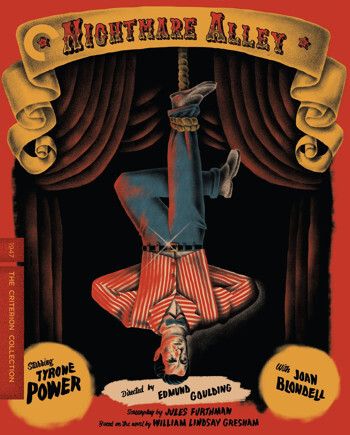
Among noir fans, I may be in the minority; but for me the Guillermo del Toro remake of Nightmare Alley misses badly.
I have pretty much universally liked del Toro’s other work, and have spoken here of how much I value Pacific Rim, Crimson Peak, and The Shape of Water. I sought out William Lindsay Gresham’s novel Nightmare Alley in high school after seeing the 1947 film version on TV, and it’s been on my shelf of favorite hardboiled literature ever since. I came to the film as a Tyrone Power fan – based upon such swashbuckling fare as The Mark of Zorro, Captain from Castille and Prince of Foxes – and was gobsmacked by his performance as Stan Carlisle, a carny who rises to prominence as a nightclub mentalist, a grifter who gets out-grifted and falls even lower than the lowly place he started.
It’s a haunting story and works best in its first film incarnation, where Tyrone Power’s handsome charmer makes us root for him at first and even continue caring about him when his flaws start bringing him down. The film is a noir buff’s dream, with Colleen Gray as innocent Molly, Joan Blondell as worldly Zeena, and the wonderful, unjustly forgotten Helen Walker (of Murder, He Says!) as a complex, chilling femme fatale, Lilith Ritter. Written by Jules Furthman (whose screenplays include everything from Mutiny on the Bounty to To Have and Have Not) and directed by Edmund Goulding (Grand Hotel, The Razor’s Edge), the film is gritty and uncompromising even while dancing around the Production Code. While the novel ends with Stan condemned to the worst job at the carnival, the film has him reunited with his wife in a superficially, censor-satisfying ending, but clearly doomed to reenact the shabby fate of Zeena and her now-dead drunken husband. (There’s an excellent Criterion edition of this, as well.)
Del Toro claims this is a return to the novel and not a remake; however, the last line of his film comes from Furthman’s screenplay, not the novel. The original film ran 111 minutes while the new Nightmare Alley is two hours and thirty minutes, the storytelling basking in itself and refusing to move along on what is, after all, a carnival ride – a story that is essentially an ironic eight-page EC Comics horror yarn.
The new Nightmare’s art direction is ridiculously lavish – the cheap carnival’s fun house set is a visual feast and at the same time all wrong, and psychiatrist Lilith Ritter’s office is an absurdly vast art deco chamber. It’s like a musical where you come away humming the sets. Meanwhile, the director misuses some of our best actors. Bradley Cooper wanders dazed through the proceedings, utterly lacking the charm and charisma that make Tyrone Power believable as a manipulative charlatan and a rogue at times worth sticking with. Toni Collette’s Zeena trades in Joan Blondell’s earth mother for a skank who immediately climbs into a bathtub with just-walked-in carny Cooper. Cate Blanchette may be sending up every femme fatale of real films noir, or she just may be struggling with a script that presents her as an immediate over-the-top cliche. Rooney Mara’s Molly does whatever the script bids her to do at any given moment, obediently going along.
I am usually not this tough on films. There’s a lot of artistry and talent on hand here, but so is a woeful misunderstanding of the source material. Nightmare Alley, both Gresham’s novel and the original film, utilize a technique I heartily approve of: a melodramatic tale with a gritty surface of realism. But Del Toro actually expands and overblows the melodrama, making Carlisle a patricidal sociopath, turning Lilith Ritter into a witchy parody, and evil kazillionaire Ezra Grindle (Richard Jenkins) into a homicidal maniac spouting the f-word as if it was already common parlance in 1941.
I saw this in a theater, wearing a mask, risking Covid – just another sucker taken for a ride at the carnival.
* * *Ron Fortier has done a lovely review of the initial title in my so-called “disaster” series.
This is a Crusin’ performance from a few years ago that features our former guitar player Jim Van Winkle, his son Teddy on trombone (an impromptu sit-in), and our much missed bass player, the late Brian Van Winkle. This was a benefit performance at the River City Music Experience in Davenport, Iowa (we were one of a number appearing). Goes out of focus for a while but straightens itself out.
M.A.C.
December 28, 2021
Bad Reviews, Christmas Movies, and Gift Cards
Five readers have added their positive reviews/ratings to No Time to Spy at Amazon, pulling our average up to four stars. This is much appreciated. Never too late to join in!
The notion that I’m thin-skinned about bad reviews is one I’m hit with now and then, understandably. But my frustration with bad reviews – specifically the mean-spirited ones like the attempt to sabotage No Time to Spy – has almost entirely to do with the impact it has on sales, because sales impact whether I can make a living or not. And in this case it will determine whether Matt Clemens and I get to write the John Sand novel we’ve been planning.
As for being thin-skinned, I am to a degree. I think all people who work in the creative arts, particularly those who make their living at it, are sensitive individuals, otherwise they wouldn’t be very creative. Most of us learn to take bad reviews in our stride, although writers (the same applies to actors, cartoonists, etc.) handle bad reviews differently – some avoid reading them, others sort through looking for the thoughtful, intelligent ones, ignoring the dumb and/or cruel ones, and genuinely try to learn from constructive criticism.
One of the basic things I’ve learned about writing fiction is its collaborative nature – it’s me plus the reader. I’ve often said words to the effect of, “Sometimes I play Broadway, other times the Three Mile Island Dinner Theater.” I’m only as good as my collaborator. Also, if my collaborator – however intelligent (including those more intelligent than me, which isn’t a small group) – does not share my world view, or at least doesn’t find my world view palatable or interesting, then we are simply not a good fit. Nothing wrong with that.
But few reviewers are wise enough to simply say, “This isn’t bad on its own terms, but it’s not my cup of tea.”
I am at a stage of my career where I am not in sync with several generations. Though I am a liberal democrat, my views are not progressive enough for those who haven’t lived as long as I have. And I will not live long enough to see karma catch up with these generations, but I smile when I think about how it will.
What specifically am I talking about? Here’s one example. It’s becoming more and more common for reviewers and social commentators and even actual readers to complain about characters in novels not having the right attitudes reflective of this cultural moment. I am coming to dread the term “politically correct” (and already dread “woke”), but please take my word for it – it’s just about impossible to write an interesting narrative when everybody in it is “nice.”
Then there’s the peculiar thing I’ve noted here several times. People complain about the explicit sex scenes in my Quarry novels and about the way he describes women, based upon their physicality in terms of sexual attractiveness. These same people never comment on the fact that Quarry is a murderer. Sometimes the explicitness of the violence gets a comment, but what book did they think they were picking up? The Hard Case Crime covers should be an indication. That the “hero” is a hired killer might be another one. Yet another would be that the books all take place decades ago (with the exception of the forthcoming Quarry’s Blood).
Similarly, Nate Heller – whose adventures take place in the mid-20th Century – is criticized for his attitudes toward women and I am scolded also for the occasional explicit sex scene. Yet not once has a reader in a comment section or a reviewer in a magazine or newspaper or on a blog commented on the fact that Heller – like Mike Hammer – often flat out kills the bad guy. Sex bad, murder good?
And when was it, exactly, that I presented Quarry or Nate Heller or for that matter Mike Hammer as a role model for enlightened males?
Watch your step, everybody. It’s getting dumb out there. Be careful you don’t trip over the falling IQ points.
* * *We had a delightful Christmas here – both Christmas Eve, when we exchange presents, and Christmas Day, with stocking presents. In both cases, Barb – who proclaims proudly that she is a bad cook – proves this to be a charade by way of preparing delicious meals on both Christmas Eve and morn.
We have been lucky throughout the Covid period to be able to interact with our son Nate, his wife Abby and our two grandchildren, Sam (6) and Lucy (3). I hope you other grandparents are bearing up under the realization that yours are not as cute and bright as ours.
But Christmas arrived much too fast, and I never got around to presenting my revised Christmas movies list here. All Barb and I watched were what have become perennials for us: both Bad Santa movies, Christmas Vacation, Office Christmas Party, the original Miracle of 34th Street and the Alistair Sim Scrooge.
The one new Christmas movie was Love Actually, which of course isn’t new at all, having been released in 2003. But we hadn’t seen it. We enjoyed it a great deal, but were struck by how practically every romantic relationship in it would be considered inappropriate today. It’s a sweet movie with a good heart, and yet I wonder when someone will attack it. Maybe they already have. Otherwise, AV and Huff Post are asleep at the switch. They better get with it – otherwise, somebody might enjoy it with a clear conscience.
* * *If you’re like me, you probably got Amazon and or Barnes and Noble gift cards as at least part of your Christmas haul. While it’s true I cashed my Amazon cards in late on Christmas Eve, not one to allow gift cards to burn a hole in my psyche, it’s possible you haven’t used yours yet.
My top three suggestions are by me – Fancy Anders Goes to War, The Many Lives of Jimmy Leighton (with Dave Thomas), and No Time To Spy (with Matthew Clemens).
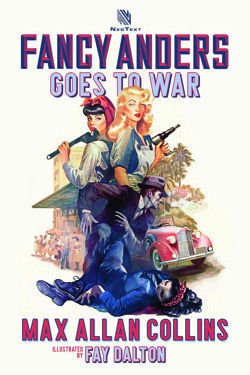
E-Book:

Paperback:

Digital Audiobook:

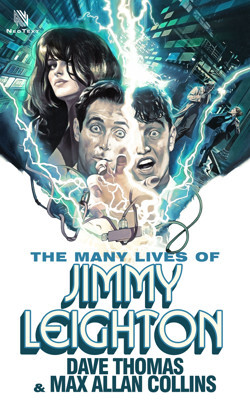
E-Book:

Paperback:

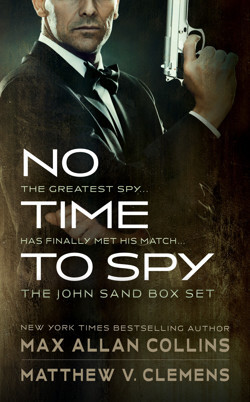
E-Book:

Paperback:

If you must use your gift cards on books I didn’t write, here are a few more suggestions:
Star Struck by Leonard Maltin. Full disclosure: Leonard is a pal, but I enjoyed this book immeasurably. It focuses on (as the secondary title tells us) his “unlikely road to Hollywood,” and his encounters with very famous people are shared in an intimate, fun, behind-the-scenes fashion. The way his love for movies, and how his fanzine led to greater things…much greater…is frankly inspiring.
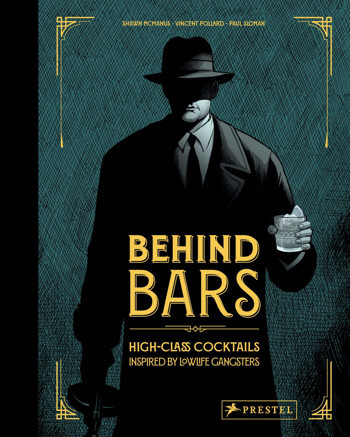
Behind Bars: High-Class Cocktails Inspired by Lowlife Gangsters by Shawn McManus, Vincent Pollar and Paul Sloman. This is a sort of recipe book for cocktails, but each one is attached to a famous real or fictional gangster with lovely illustrations of those gangsters by McManus. Now, I’m not a big drinker, but this resonated with me. Why? Michael Sullivan Sr (AKA O’Sullivan) of Road to Perdition fame/infamy is not only included…he’s on the cover! I am highly complimented! (Although not at all compensated.)
The Art of Pulp Fiction: An Illustrated History of Vintage Paperbacks by Ed Hulse. This is a lovely, lavishly illustrated history of paperbacks with info on artists. However…the first paperback cover of I, the Jury was not by the great Lu Kimmel, who did the next version; the original (pictured in Art of Pulp Fiction) was by Tony Varaday. And the hardcover edition did invoke Mickey Spillane’s famous last scene, just the aftermath not the build-up. But this isn’t the kind of book you read for text.
* * *My old friend Paul Kupperberg was nice enough to include the Jake and Maggie Starr trio of comics-related mysteries on his list of comic book histories and biographies. We don’t exactly fit, but who cares? It’s nice to be noticed.
Happy 2022!
M.A.C.



